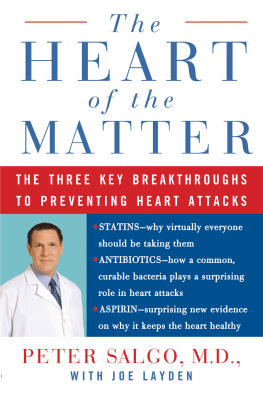ASPIRIN THE REMARKABLE STORY OF A WONDER DRUG
DIARMUID JEFFREYS

CONTENTS
For my parents
SOMEWHERE CLOSE BY - in the bathroom cabinet, tucked away in a desk drawer, at the bottom of an old jacket pocket - there'll be a container with some aspirin in it. Take out a tablet and examine it for a moment.
It's a pretty innocuous-looking thing, isn't it? Just an ordinary little white pill. You've seen hundreds of them before and no doubt you'll see hundreds of them again. It's nothing special.
Look again and consider this. What you're holding is one of the most amazing creations in medical history, a drug so astonishingly versatile that it can relieve your headache, ease your aching limbs, lower your temperature and treat some of the deadliest human diseases. There's now evidence to show that aspirin might prevent heart attacks, strokes, deep vein thrombosis, bowel, lung and breast cancer, cataracts, migraine, infertility, herpes, Alzheimer's disease, and much else. The list is growing every year which might go some way towards explaining why over 25,000 scientific papers have been written about aspirin and why an estimated one trillion little white pills, just like yours, have been consumed since it first came into being.
In short, what you have there is a wonder drug, something with few equivalents in the annals of medical science, and one of the most endurably successful commercial products of all time.
I first became interested in this extraordinary substance several years ago when my father had a serious heart attack. Fortunately, to the great relief of all of us who love him, he recovered and is now fit and well. But since then he's taken a small aspirin tablet daily to keep the blood flowing through his arteries. In recent years, my mother has started taking aspirin too, for much the same reason, and the two of them now follow a strict regimen of one 75 mg dose every day.
It got me wondering. Where did this drug come from? How did something evolve from an ordinary headache pill into a drug that can save lives? The little I knew about aspirin's origins came from a half-remembered lesson at school - namely, that a German chemical company had invented it sometime in the nineteenth century.
But when I began to look into it I realized that here was a far richer, more complex and much older tale; that this little chemical marvel had the most incredible history. Out of that realization grew this book.
Although we now take it for granted, aspirin didn't just appear from nowhere. It's a product of a roller-coaster ride through time, of accidental discoveries and intuitive reasoning, of astounding scientific ingenuity, personal ambition and intense corporate rivalry. Its past embraces, in no particular order: wars, epidemics, an Oxford shire vicar, a forgotten Jewish scientist, ancient papyrus scrolls, the Industrial Revolution, a nineteenth-century Scottish fever hospital, a common tree, espionage, a mighty German industrialist, malaria, the Treaty of Versailles, the colour mauve, the City of Hull, Lily the Pink, the world's most powerful pharmaceutical companies, a twitching rabbit aorta, Auschwitz, a mercurial advertising genius, and a great deal more.
I found that there was nothing predetermined about the way all these things came together or the impact they had. If chance had not sometimes played a huge role in its development, aspirin might never have come into existence. Had it not thrived through profit-driven competition, it might never have survived to release its incredible therapeutic benefits. But come together they did a great mosaic of people, places and events that combined, little by little, to give us one of the most remarkable inventions in history.
This, then, is aspirin's story. And like all really good stories it began a long time ago...
1
IF YOU EXAMINE A MAN...
IT HAD BEEN a long afternoon. They had sat down when the midday sun was flooding the room; now the only light came from an oil lamp swaying gently over their heads. It cast strange flickering shadows on to the walls and over the two heaps of objects that lay on the low table in front of them. These were evidence of their cautious preliminary fencing - the half-dozen scarabs and amulets that the American had been persuaded to buy, and a much larger pile of those he hadn't. But now they had arrived at the critical point in their discussions, the real reason why they were there and the moment for which, like all good salesmen, they had bided their time. As one of them untied the linen wrapper from around the scrolls, his brother watched the American's face for any flicker of interest. They knew he had a weakness for these pieces of old papyrus and had sold him some before, but he could drive a hard bargain and was quite capable of rejecting anything he considered worthless or uninteresting. Unfortunately, the American was the only one among them who could even attempt to decipher the pictures and symbols that covered the papyri, and so they had to wait and gauge his reaction before they knew if they could expect a deal.
For his part, Edwin Smith struggled to conceal his excitement. His landlord Mustapha Agha, watching impassively from a corner, had warned him to expect something special. Smith knew, of course, that Agha would be getting a healthy commission on anything sold that evening and that it was therefore in his interest to inflate the value of the artefacts on offer. But the brothers Ahmed and Mohammed Abd er-Rasul were different from the ordinary touts who pestered rich tourists in Luxor market. They were the city's most successful grave-robbers. For years they'd been Agha's main suppliers of antikas and they invariably came up with something worthwhile. Even their fakes - which they knocked up between forays underground - were remarkably convincing. Smith had bought and sold on enough of them himself to know that.
In any case, if what he had been told earlier was true, these papyri really could be unique. Agha had said they had been found between the feet of a mummy in the Assassif area of the Theban necropolis, on the other side of the Nile. Smith knew that the brothers had found their way into a number of officially 'undiscovered' tombs at Assassif - he had obtained some of his best artefacts from that source. If these scrolls were genuinely from the same place, they would bear close examination.
He leant forward and peered intently at the hieratic text, revealed as the first scroll was opened out under the lamplight. It was long, one of the longest he'd ever seen, and covered with a bewildering array of symbols. But they were written in a clear hand; the nameless author must have been a practised and painstaking scribe. Smith murmured to himself, lost in the beauty of a document that had survived almost three millennia. He began to pick out the meaning of some of the words... Tf you examine a man...'
The three Egyptians watched him, exchanged meaningful glances and then settled back comfortably to wait. They knew now that their patience would be rewarded.
Edwin Smith was born in Bridgeport, Connecticut in April 1822. Although details of his early life are sketchy, it is clear that his father, Sheldon, was wealthy enough to provide him with a good education in New York, London and Paris. In his late twenties Edwin married, had children and for a while lived the life of a prosperous gentleman of leisure in New England. But then in his early thirties he became involved in a scandal of some kind and was forced to leave the United States. Whatever the cause of the row, it left him estranged from his family, down on his luck and cut off from funds. He was forced to earn a living as best he knew how. And what Smith knew best was Egypt. Ever since Napoleon's armies had swept down the Nile some fifty years earlier, the land of the pharaohs had fascinated the Western world. Egyptology had become a fashionable subject for serious academic study in Europe and America and tourists now added their graffiti to that carved by La Grande Armee on the monuments of the ancient kings. As a young man Smith had developed an interest in Egypt and read excitedly of the archaeological discoveries being made there. He had studied hieratic - the written language of pictograms and hieroglyphics used by the Ancient Egyptians that was being painfully deconstructed by professional scholars from clues in scraps of old papyrus and tablets like the Rosetta Stone. In fact he became something of an expert albeit an amateur one - and when he was looking for a place to establish himself, far away from the miseries of his personal life, it was only natural that he turned to Egypt.
Next page










